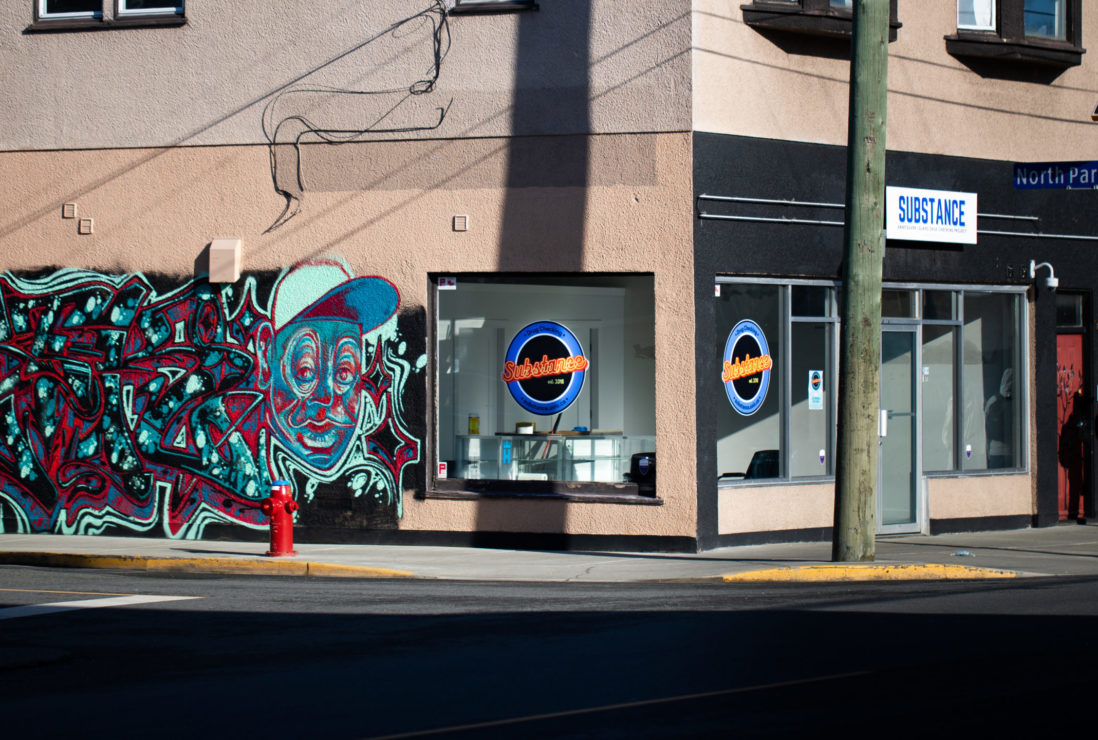
Eventual expansion put on hold as project seeks Health Canada exemptions
The Vancouver Island Drug Checking Project, an interdisciplinary collaboration between the University of Victoria and Health Canada, has a new home. Following months of moving around in conjunction with provincial health orders, the project recently opened up their own storefront at 1802 Cook Street, near Royal Athletic Park. The project offers anonymous drug-checking services to community members and provides non-judgemental answers to those seeking to learn more about recreational drug use.
The project was started in 2018 by the Canadian Institute for Substance Use Research (CISUR) at the University of Victoria through funding provided by Health Canada and a myriad of research grants in different disciplines from across Canada. It is run by UVic professors Dennis Hore, Bruce Wallace, and Bernie Pauly. It has since initiated partnerships with the Vancouver Foundation, Island Health, SOLID Outreach, Aids Vancouver Island (AVI), and numerous other advocacy groups.
For most of the last three years, the project has been operating out of overdose prevention sites. However, with the onset of the pandemic, the project was forced to find other spaces in which to operate as public health orders closed many outreach and overdose prevention sites to the public. For several months, they operated out of a hotel near the Gorge. They eventually found an open space on Cook Street and in mid-March they opened the doors to their new premises.
“It was a real challenge to continue operating through the pandemic, because the locations we were in were forced to close to public access,” Wallace told the Martlet.
Although it is early days yet, Wallace says the new space appears to be doing well with more and more people coming in each day.
The process for checking drugs only takes 20 minutes.
“When somebody comes in, we ask some basic questions,” said Wallace. “One of the primary questions is for somebody to say what they expect the substance to be.”
Once the client informs staff what they believe the substance is, tests can be run to determine the sample’s composition. This can take the form of either a simple swab test or a highly advanced spectrometer reading. Staff then read the results to figure out not only the composition but also what the active ingredient is and whether the substance is pure or has been cut, which means that there have been alterations or additions to the substance such as fentanyl.
As the overall focus of the project is on building awareness and reducing the stigma around drug use, volunteer staff follow harm reduction guidelines when speaking with clients. Wallace says that he hopes this approach will make members of the community comfortable coming in and that it will help to reduce the number of overdoses occurring in the province.
In 2020 alone, more than 1 700 people died from drug overdose in B.C. The COVID-19 pandemic has exacerbated many of the causes of overdose including lack of safe supply, mental health crises, and inadequate support systems.
Wallace says he would like to see the government work to change current drug policies and make decriminalization of drug use a high priority. Right now, the project is limited to testing those substances that users bring in themselves. However, Wallace aims to expand all across Vancouver Island by having users and overdose prevention sites courier substances to the project’s main site for testing. This expansion requires a further exemption from the government due to the illegality of the substances they work with.
Wallace says that he would like to see the government move towards decriminalization which would not only allow for an expansion of safe supply, but also would help facilitate harm reduction and drug-checking services.
“I think there’s real support for expanding the service and there’s a real frustration about how hard it is to do it within this context of criminalization,” said Wallace. “The drug laws are really designed to prohibit the activities that we need to do to actually engage with harm reduction.”
Besides the support the project provides to the community, it also serves as a research and volunteer opportunity for undergraduate and graduate students in a variety of fields from chemistry to social work.
Chemistry graduate student Margo Ramsay says that being involved in the project has opened her eyes to the world of harm reduction and given her a chance to make connections with people working in the field.
Ramsay is completing her thesis on fentanyl quantification methods and says that prior to working on the project, she had no idea about the number of people who willingly choose to use the drug most often blamed for the overdose crisis.
“One thing that occurred to me pretty early on, and most people working product realize this, is there are people out there who are, for example, seeking fentanyl, and are knowingly using fentanyl,” Ramsay told the Martlet. “So, it’s more about how to work with them, to kind of empower them, and give them more information so that they can make safer decisions or more informed decisions.”
With the project testing just under 1 300 samples in 2020, it is clear that it has become an important avenue for making sure that members of the community are educated about recreational drug use and are aware of what substances they are using. Wallace hopes that the new storefront will make more people aware of the services they offer and encourage people to use them.
“What we’re trying to also do in having this storefront location is to recognize that drugs are in society, and that people who use drugs shouldn’t face stigmatization, and the criminalization of drugs and people who use drugs is also linked to the deaths in our province,” said Wallace. “People talk about anti-stigma campaigns — what does that look like? For us, I think it means having a storefront and being really welcoming and informative.”








